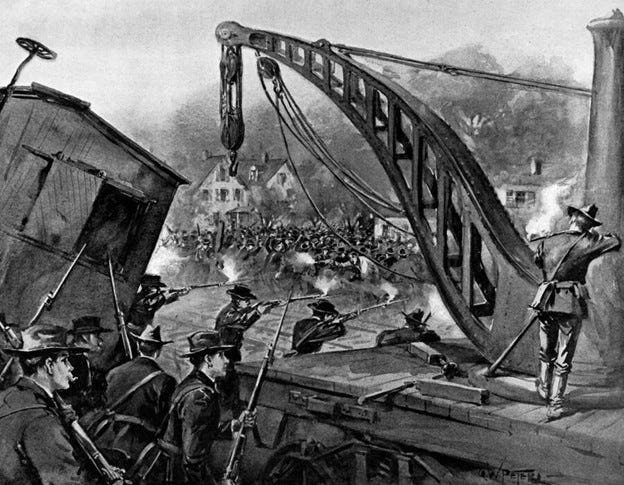Censored At School: The Pullman Strike
“The paternalism of the Pullman is the same as the interest of a slaveholder in his human chattels. You are striking to avert slavery and…
“The paternalism of the Pullman is the same as the interest of a slaveholder in his human chattels. You are striking to avert slavery and degradation.” — Eugene V. Debs, President of the American Railways Union, May 16th, 1894
Our story begins with the founding of an American feudal town named Pullman.
In 1880, 4,000 acres of land was acquired just south of Chicago. The purchaser was George Pullman, an industrialist and innovator. He was the king of the sleeper cars on passenger trains.
George believed that workers needed to be controlled for their own benefit. He also believed that he could maximize profitability with a company town.
In the company town of Pullman, George owned the schools, the shops, the housing, the theater — even the church. He set the rents and deducted them from employee paychecks. There was no drinking, no 8-hour workday idleness, and — most especially — no unions. Not in this town.
The national economy has its ups and downs. In 1893, a depression hit the United States. Pullman’s profits were not unscathed.
To combat this constriction in the economy, Pullman made some cuts. Wages dropped over 30%. Headcount was reduced by a third.
Luckily, the company stock dividends remained untouched.
The price of housing and store supplies also went unchanged.
“The scenes enacted at the bank during last winter were pitiable….One man has a pay check in his possession of two cents after paying rent. He has never cashed it, preferring to keep it as a memento.” — The Pullman Strike by Rev. William H. Carwardine p69
“Starvation wages” became the name of the game.
The strike began on May 11th, 1894 with 4,000 working-class Americans who refused their serfdom. Their situation was dire — they were going to war out of desperation, not strength.
The American Railways Union (ARU) joined the fight on June 26th.
Those 4,000 desperate strikers suddenly had another 150,000 friends in what quickly became one of the largest working class struggles in American history.
Workers across the country acted in solidarity. Sleeper cars were detached from trains and set aside until the demands of their laboring brothers no longer fell on deaf ears.
Trains stopped running.
Time passed. The strike spread. Lawsuits happened.
US President Grover Cleveland, against the wishes of then Illinois Governor John Altgeld, sent in the troops.
Federal troops occupied Chicago on July 4th, 1894. They were met with riots.
The situation became more die. People were starving. Scabs (strike-breakers) were brought in. They were met with resistance. Sleeper cars were burned.
On July 7th the national guard (yes, this national guard) opened fire on the striking workers. The death toll, in the sources that choose to report it, have the dead ranging from 30 to as high as 70 workers. Reports of the injured range from over 50 people to simply “many”.
These workers weren’t armed. The national guard suffered no losses.
State violence ultimately ended the strike. Leaders, including Debs, were arrested and imprisoned. Workers were either blacklisted and starved or were re-hired under “yellow dog” contracts that banned unionizing.
On June 28th, a few days before sending in the troops, Grover Cleveland (D) signed legislation making Labor Day a federal holiday.
He was not, and will not, be remembered as a friend.
Print Sources
Dynamite: The Story of Class Violence In America by Louis Adamic p85–90
A People’s History of The United States by Howard Zinn p253–295, but especially p278–282
The Pullman Strike by Rev. William H. Carwardine, especially p69
Web Sources
https://libcom.org/article/pullman-strike-1894-jeremy-brecher
https://www.thoughtco.com/the-pullman-strike-of-1894-1773900
https://allthatsinteresting.com/pullman-strike
http://www.illinoislaborhistory.org/labor-history-articles/the-parable-of-pullman
https://www.legendsofamerica.com/pullman-illinois/
https://www.pullman-museum.org/images/recSurvey.pdf
https://www.pullmanil.org/the-history-of-pullman/
https://www.history.com/news/labor-day-pullman-railway-strike-origins
https://www.nps.gov/pull/learn/historyculture/the-pullman-story-part-2.htm
https://www.pullman-museum.org/theCompany/
Hey You!
Want to be my hero? Support me on Ko-Fi today!
If you’ve read this far, engagement goes a long way. Leave a comment and let me know what you think about the article! Claps, comments, follows, shares, and subscribes are always appreciated.
Have a good one!




